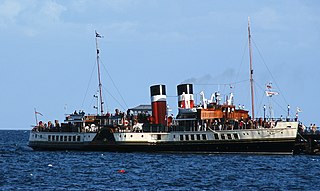Related Research Articles

A steamship, often referred to as a steamer, is a type of steam-powered vessel, typically ocean-faring and seaworthy, that is propelled by one or more steam engines that typically move (turn) propellers or paddlewheels. The first steamships came into practical usage during the early 1800s; however, there were exceptions that came before. Steamships usually use the prefix designations of "PS" for paddle steamer or "SS" for screw steamer. As paddle steamers became less common, "SS" is incorrectly assumed by many to stand for "steamship". Ships powered by internal combustion engines use a prefix such as "MV" for motor vessel, so it is not correct to use "SS" for most modern vessels.

Atlantic Conveyor was a British merchant navy ship, registered in Liverpool, that was requisitioned during the Falklands War.

CP Ships was a large Canadian shipping company established in the 19th century. From the late 1880s until after World War II, the company was Canada's largest operator of Atlantic and Pacific steamships. Many immigrants travelled on CP ships from Europe to Canada. In 1914 the sinking of the Canadian Pacific steamship RMS Empress of Ireland just before World War I became largest maritime disaster in Canadian history. The company provided Canadian Merchant Navy vessels in World Wars I and II. Twelve vessels were lost due to enemy action in World War II, including the RMS Empress of Britain, which was the largest ship ever sunk by a German U-boat.

The Gas Light and Coke Company, was a company that made and supplied coal gas and coke. The headquarters of the company were located on Horseferry Road in Westminster, London. It is identified as the original company from which British Gas plc is descended.
Cambria was the name of a number of steamships.

Park ships were merchant steamships constructed for Canada’s Merchant Navy during the Second World War. Park ships and Fort ships were the Canadian equivalent of the American Liberty ships. All three shared a similar design by J.L. Thompson and Sons of Sunderland, England. Fort ships had a triple expansion steam engine and a single screw propeller. Fort ships were ships transferred to the British government and the Park ships were those employed by the Canadian government, both had the similar design. Park ships were named after local and National Parks of Canada. A few Park ships were launched as "Camp ships", named after Canada military camps, but were quickly renamed after Parks. Jasper Park was the first Park ship lost to enemy attack, in the Indian Ocean after a torpedo attack from U-177 in the Indian Ocean, South of Durban, South Africa.
TSS Hibernia was a twin screw steamer passenger vessel operated by the London and North Western Railway from 1920 to 1923, and the London, Midland and Scottish Railway from 1923 to 1948.
SS Mohamed Ali El-Kebir, formerly SS Teno, was one of a pair of steam turbine ocean liners built in Scotland in 1922 for the Chilean company CSAV. She and her sister ship Aconcagua ran between Valparaíso and New York via the Panama Canal until 1932, when CSAV was hit by the Great Depression and surrendered the two ships to the Scottish shipbuilder Lithgows to clear a debt.

TSS Carlotta was a London, Tilbury and Southend Railway passenger ferry, in service between Tilbury and Gravesend from 1893 until 1930.

TSS Vienna was a passenger vessel built for the Great Eastern Railway in 1894.
TSS Norwich was a passenger vessel built for the Great Eastern Railway in 1883.
TSS Train Ferry No. 2 was a freight vessel built for the British Army War Office in 1917.
TSS Lorina was a passenger vessel built for the London and South Western Railway in 1918.
Several vessels have borne the name Kitty, a diminutive for the name "Catherine", and a name in its own right:
TSS Princess Maud was a ferry that operated from 1934 usually in the Irish Sea apart from a period as a troop ship in the Second World War and before being sold outside the United Kingdom in 1965. She was built by William Denny and Brothers of Dumbarton on the Firth of Clyde for the London Midland and Scottish Railway (LMS). When the LMS was nationalised in 1948 she passed to the British Transport Commission and onward to British Rail in 1962. She was sold to Lefkosia Compania Naviera, Panama in 1965. Renamed Venus she was for service in Greek waters. It is understood she saw use as an accommodation ship in Burmeister & Wain, Copenhagen.
Several vessels have been named Aberdeen:
Several ships have been named Majestic:

Sieling & Jarvis Inc. was a shipping company that operated tanker ships and some cargo ships. Sieling & Jarvis was started by David B. Jarvis and Dick Sieling in New York City. Later David B. Jarvis was the company president and later became the sole owner of Sieling & Jarvis Inc. Mr. Sieling was the vice president and a partner in Sieling & Jarvis. Sieling & Jarvis supported the World War II effort by operating United States owned ships.
References
- Craig, Robert, & Rupert Jarvis (1967) Liverpool Registry of Merchant Ships. (Manchester University Press for the Chetham Society), Series 3, vol. 15.